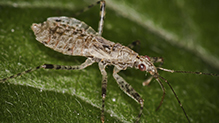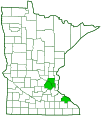damsel bug
(Hoplistoscelis pallescens)
Conservation • Description • Habitat • Ecology • Distribution • Taxonomy
Conservation Status |
|
|||||||
| IUCN Red List | not listed |
|||||||
| NatureServe | not listed |
|||||||
| Minnesota | not listed |
|||||||
Description |
||
Hoplistoscelis pallescens is a common, small, predatory, damsel bug. It occurs in the United States from vermont to virginia, west to Minnesota and Iowa. It also occurs in southern Canada in Quebec and Ontario. It is found in woodlands and is reported to be infrequently taken in sweeps of “undergrowth in the woods and woodland grasses.” Adults and nymphs prey on aphids, mites, caterpillars, and the eggs, larvae, and nymphs of other insects. Adults are soft-bodied, elongate oval, and ¼″ to 5⁄16″ (6.5 to 8.0 mm) in length. Females are wider behind than males. The body is light brown (pale) with dark brown to black (dark) markings. The head is small, cone-shaped, and much narrower than the thorax. The neck is short. There are two large compound eyes and two small simple eyes (ocelli). The compound eyes are bulging. The antennae are exposed, conspicuous, and long, much longer than the head but not quite as long as the body. They have four segments. The first segment (scape) is about as long as the head and is not abruptly thickened toward the end. The second and third segments are about 25% longer than the scape. The fourth segment is shorter than the scape. The mouth parts are optimized for piercing and sucking. They take the form of a long, prominent, 4-segmented beak (rostrum) that extends along the underside of the body between the legs when not used. The beak is slender and much longer than the head. The plate on the first segment of the thorax (pronotum) is pale with some irregular transverse lines above and several short stripes near the base. The front of the pronotum is narrowed into a distinct wide collar. The small triangular plate between the wing bases (scutellum) has conspicuous, semicircular, pale spots on each basal angle. The abdomen is much wider than the thorax and has a flattened, greatly enlarged margin (connexivum). It is widest in the middle, with smooth, rounded lateral sides and a broadly rounded tip (apex). The front margin of the convexia of abdominal segments 2 through 5 are dark. The convexia on segment 6 has a large dark blotch on the front margin. Adults with full-sized, fully functional wings (macropterous) are rare. When fully developed, the forewings (hemelytra) extend slightly beyond the tip of the abdomen. On macropterous males the hemelytra completely conceal the convexia. On macropterous females the convexia are broadly exposed. Most adults have short, nonfunctional wings (brachypterous) that do not extend beyond the middle of the second abdominal segment. The legs are long, slender, and yellowish-tan. The third segment (femur) on the front legs is slightly enlarged and it has numerous dark spots. The underside of The femurs on the front and middle legs has numerous blunt, dark teeth and spine-like hairs (setae). The femurs on the middle and hind legs has dark rings near the tip. The tibia on all legs has dark rings. The end part of the leg (tarsus), corresponding to the foot, has 3 segments. |
||
Size |
||
¼″ to 5⁄16″ (6.5 to 8.0 mm) |
||
Similar Species |
||
Habitat |
||
|
||
Ecology |
||
Season |
||
Multiple generations per year: May to October. |
||
Behavior |
||
|
||
Life Cycle |
||
Adults overwinter in weedy areas, agricultural crops, borders of fields, and roadsides. They hibernate beneath logs, in the basal leaves of mullein, in shrubs, or in other sheltered places. In the spring, females deposit eggs on plants. |
||
Nymph Food |
||
Same as adult |
||
Adult Food |
||
Aphids, mites, caterpillars, and the eggs, larvae, and nymphs of other insects |
||
Distribution |
||||
|
Sources |
|||
| 10/2/2023 | ||||
Occurrence |
||||
|
||||
Taxonomy |
|||
Order |
Hemiptera (True bugs, Hoppers, Aphids, and Allies) | ||
Suborder |
Heteroptera (True Bugs) | ||
Infraorder |
Cimicomorpha | ||
Superfamily |
Cimicoidea | ||
Family |
Nabidae (damsel bugs) | ||
Subfamily |
Nabinae | ||
Tribe |
Nabini | ||
Genus |
Hoplistoscelis | ||
Superfamily Species |
|||
Synonyms |
|||
|
|||
Common Names |
|||
This species has no common name. The common name of the family Nabidae is damsel bugs, and it is applied here for convenience. |
|||
Glossary
Connexivum
In Heteroptera: the enlarged, flattened margins of the abdomen. Plural: connexiva.
Femur
On insects and arachnids, the third, largest, most robust segment of the leg, coming immediately before the tibia. On humans, the thigh bone.
Hemelytron
The forewing of true bugs (order Hemiptera), thickened at the base and membranous at the tip. Plural: hemelytra.
Ocellus
Simple eye; an eye with a single lens. Plural: ocelli.
Pronotum
The exoskeletal plate on the upper side of the first segment of the thorax of an insect.
Rostrum
The stiff, beak-like projection of the carapace or prolongation of the head of an insect, crustacean, or cetacean.
Scape
In plants: An erect, leafless stalk growing from the rootstock and supporting a flower or a flower cluster. In insects: The basal segment of the antenna.
Scutellum
The exoskeletal plate covering the rearward (posterior) part of the middle segment of the thorax in some insects. In Coleoptera, Hemiptera, and Homoptera, the dorsal, often triangular plate behind the pronotum and between the bases of the front wings. In Diptera, the exoskeletal plate between the abdomen and the thorax.
Seta
A stiff, hair-like process on the outer surface of an organism. In Lepidoptera: A usually rigid bristle- or hair-like outgrowth used to sense touch. In mosses: The stalk supporting a spore-bearing capsule and supplying it with nutrients. Plural: setae. Adjective: setose.
Tarsus
On insects, the last two to five subdivisions of the leg, attached to the tibia; the foot. On spiders, the last segment of the leg. Plural: tarsi.
Tibia
The fourth segment of an insect leg, after the femur and before the tarsus (foot). The fifth segment of a spider leg or palp. Plural: tibiae.
Visitor Photos |
|||||
Share your photo of this insect. |
|||||
| This button not working for you? Simply email us at info@MinnesotaSeasons.com. Attach one or more photos and, if you like, a caption. |
|||||
Scott Bemman |
|||||
 |
|||||
MinnesotaSeasons.com Photos |
|||||
|
|||||

Slideshows |
||

Visitor Videos |
|||
Share your video of this insect. |
|||
| This button not working for you? Simply email us at info@MinnesotaSeasons.com. Attach a video, a YouTube link, or a cloud storage link. |
|||
Other Videos |
|||

Created: 10/2/2023
Last Updated:


